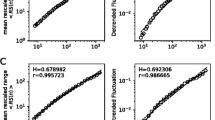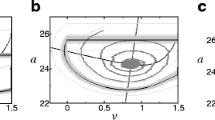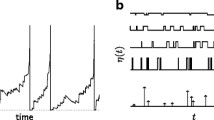Abstract
A generalized version of the integrate-and-fire model is presented that qualitatively reproduces firing rates and membrane trajectories of motoneurons. The description is based on the spike-response model and includes three different time constants: the passive membrane time constant, a recovery time of the input conductance after each spike, and a time constant of the spike afterpotential. The effect of stochastic background input on the peristimulus time histogram (PSTH) response to spike input is calculated analytically. Model results are compared with the experimental data of Poliakov et al. (1996). The linearized theory shows that the PSTH response to an input spike is proportional to a filtered version of the postsynaptic potential generated by the input spike. The shape of the filter depends on the background activity. The full nonlinear theory is in close agreement with simulated PSTH data.
Similar content being viewed by others
References
Abeles M (1991) Corticonics. Cambridge University Press, Cambridge.
Bernander Ö, Douglas RJ, Martin KA, Koch C (1991) Synaptic background activity influences spatiotemporal integration in single pyramidal cells. Proc. Natl. Acad. Sci. USA 88: 11569–11573.
Calvin WH, Stevens CF (1968) Synaptic noise and other sources of randomness in motoneurone interspike intervals. J. Neurophysiol. 31: 574–587.
Cox DR (1962) Renewal Theory. Methuen, London.
Paré D, Shink E, Gaudreau H, Destexhe A, Lang EJ (1998) Impact of spontaneous synaptic activity on the resting properties of cat neocortical neurons in vivo. J. Neurophysiol. 79: 1450–1460.
Fetz EE, Gustafsson B (1983) Relation between shapes of postsynaptic potentials and changes in firing probability of cat motoneurones. J. Physiol. 341: 387–410.
Gerstner W (1995) Time structure of the activity in neural network models. Phys. Rev. E. 51(1): 738–758.
Gerstner W (2001) A framework for spiking neuron models: The spike response method (Preprint). In: Gielen S, et al., eds. The Handbook of Biological Physics Elsevier, Amsterdam, pp. 469–516. Available at http://diwww.epfl.ch/lami/team/gerstner/.
Gerstner W (2000) Population dynamics of spiking neurons: Fast transients, asynchronous states and locking. Neural Comput. 12: 1–46.
Granit R, Kernell D, Lamarre Y (1966) Algebraic summation in synaptic activation of motoneurones firing within the ‘primary range’ to injected currents. J. Physiol. 187: 379–399.
Gustafsson B, McCrea D (1984) Influence of stretch-evoked synaptic potentials on firing probability of cat spinal motoneurones. J. Physiol. 347: 431–451.
Hausser M, Clark BA (1997) Tonic synaptic inhibition modulates neuronal output pattern and spatiotermporal synaptic integration. Neuron. 19: 665–678.
Herrmann AK, Gerstner W (2000) Noise and the PSTH response to current transients: I. General theory and application to the integrate-and-fire neuron. J. Comp. Neurosci.
Jones KE, Bawa P (1999) A comparison of human motoneuron data to simulated data using cat motoneuron models. J. Physiol. Paris 93(1- 2): 43–59.
Kirkwood PA (1979) On the use and interpretation of crosscorrelation measurements in the mammalian central nervous system. J. Neurosci. Methods 1: 107–132.
Kirkwood PA, Sears TA (1978) The synaptic connexions to intercostal motoneurones as revealed by the average common excitation potential. J. Physiol. 275: 103–134.
Kirkwood PA, Sears TA (1991) Cross-correlation analysis of motoneurone inputs in a co-ordinated motor act. In: Krüger J, ed. Neuronal Co-operativity. Springer-Verlag, Berlin. pp. 225–248.
Kistler WM, Gerstner W, van Hemmen JL (1997) Reduction of Hodgkin-Huxley equations to a single-variable threshold model. Neural Comput. 9: 1015–1045.
Knox CK (1974) Cross-correlation functions for a neuronal model. Biophys. J. 14: 567–582.
Lindsley BG, Gerstein GL (1979) Interactions among an ensemble of chordotonal organ receptors and motor neurons of the crayfish claw. J. Neurophysiol. 42: 383–399.
Matthews PBC (1996) Relationship of firing intervals of human motor units to the trajectory of post-spike after-polarization and synaptic noise. J. Physiol. 492.2: 597–628.
Midroni G, Ashby P (1989) How synaptic noise may affect crosscorrelations. J. Neurosci. Meth. 27: 1–12.
Moore GP, Perkel DH, Segundo JP (1966) Statistical analysis and functional interpretation of neuronal spike data. Ann. Rev. Physiol. 28: 493–522.
Moore GP, Segundo JP, Perkel DH, Levitan H (1970) Statistical signs of synaptic interaction in neurons. Biophys. J. 10: 876–900.
Paré D, Shink E, Gaudreau H, Destexhe A, Lang E (1998) Impact of spontaneous synaptic activity on the resting properties of cat neocortical neurons in vivo. J. Neurophysiol. 79: 1450–1460.
Perkel DH, Gerstein GL, Moore GP (1967) Neuronal spike trains and stochastic point processes I. The single spike train. Biophys. J. 7: 391–418.
Piotrkiewicz M, Churikova L, Person R (1992) Excitability of single firing human motoneurones to single and repetitive stimulation (experiment and model). Biol. Cybern. 66(3): 253–259.
Plesser HE, Gerstner W (2000) Noise in integrate-and-fire neurons: From stochastic input to escape rates. Neural Comput. 12: 367–384.
Poliakov AV (1991) Synaptic noise and the cross-correlation between motoneuron discharges and stimuli Neuro Report 2: 489–492.
Poliakov AV, Powers RK, Binder MD (1997) Functional identification of the input-output transforms of motoneurones in the rat and cat. J. Physiol. 504(Pt. 2): 401–424.
Poliakov AV, Powers RK, Sawczuk A, Binder MD (1996) Effects of background noise on the response of rat and cat motoneurones to excitatory current transients. J. Physiol. 495(Pt. 1): 143–157.
Powers RK, Binder MD (1996) Experimental evaluation of inputoutput models of motoneuron discharge. J. Neurophysiol. 75: 367–379.
Schwindt PC, Calvin WH (1973) Nature of conductances underlying rhythmic firing in cat spinal motoneurons. J. Neurophysiol. 36: 955–973.
Stevens CF, Zador AM (1998) Novel integrate-and-fire-like model of repetitive firing in cortical neurons. In: Proceedings of the Fifth Joint Symposium on Neural Computation, UCSD, La Jolla, CA. Available at http://www.sloan.salk.edu/~zador/rep fire inc/rep fire inc.html.
Author information
Authors and Affiliations
Rights and permissions
About this article
Cite this article
Herrmann, A., Gerstner, W. Noise and the PSTH Response to Current Transients: II. Integrate-and-Fire Model with Slow Recovery and Application to Motoneuron Data. J Comput Neurosci 12, 83–95 (2002). https://doi.org/10.1023/A:1015739523224
Issue Date:
DOI: https://doi.org/10.1023/A:1015739523224




